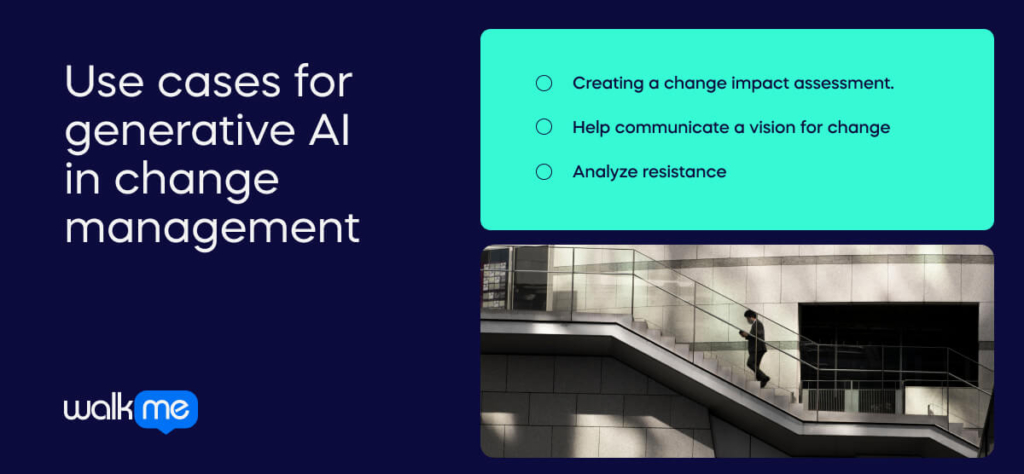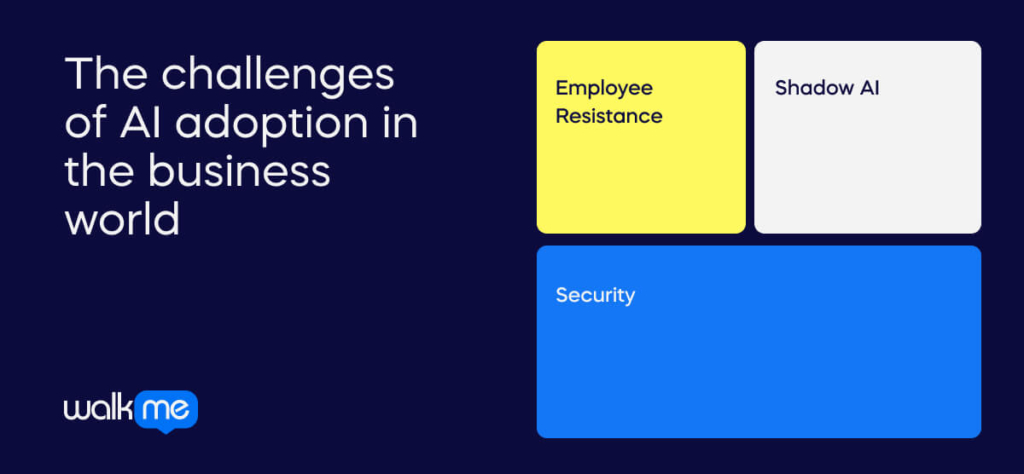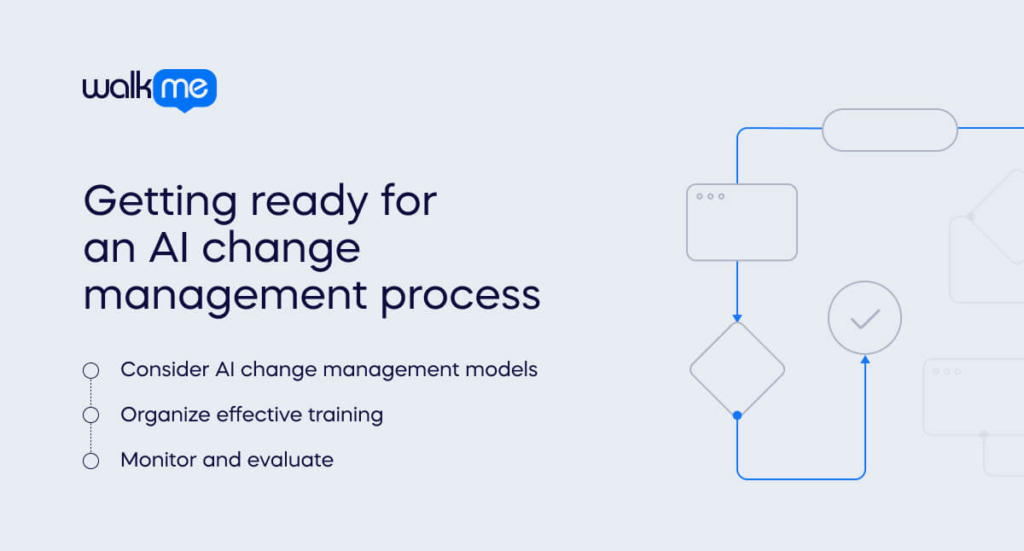“AI in change management” usually means one of two things. It can be the use of AI for general change management projects (whether or not they are about artificial intelligence or technology). Alternatively, it means using change management to help companies with the challenges of AI adoption.
In this article, we will introduce both of these possibilities. After all, both areas are still in their infancy.
Business leaders now understand that they must use AI to stay competitive. However, the applications in every aspect of leadership are still unclear.
To help navigate the opportunities and challenges of AI for change management, this article will:
- Define the meaning of AI change management;
- Introduce the use cases for AI in change management projects;
- Explain the challenges for the change management of AI technology;
- Offer some strategies for managing change in AI adoption.
In the future, AI technology will be another valuable change management tool to support organizational transition to new states. So, now’s the time to prepare for what it could do for you.
What is AI change management?
As mentioned above, AI change management can be one of two things.
- It is the discipline of using AI to enhance change management projects. Or,
- It is the discipline of using change management to ensure that AI is adopted effectively.
Both areas are preparing for important innovations in the current era of generative AI. AI-powered tools can provide major administrative support for change management processes, leading to efficiencies, enhanced employee engagement, and excellent decision-making.
Business technology leaders have used forms of AI and Machine Learning (ML) for years – for automation tasks, data analytics, and recommendation systems. However, in 2023, the doors have opened wide to the possibilities of generative AI.
As such, generative AI tools – like ChatGPT, Bard, and Jasper – will be the main focus of this article.
Use cases for generative AI in change management

In September 2023, a snapshot survey from Prosci revealed that 48% of change managers were not using AI for their professional work at all – and a further 25% were only using it “a little.” With these ideas, these figures will likely change in the coming years.
Right now, the major use cases applications might be the domain of amateur prompt engineers. But as time passes, more user-friendly applications like Duet for Google Workspace are emerging.
This section will look at three important use cases: change impact assessments, communication, and resistance analysis.
Creating a change impact assessment.
Generative AI can be highly valuable for creating a change impact assessment because it can simulate and predict various scenarios and their potential effects on an organization.
Generating realistic and diverse scenarios can provide change managers with a comprehensive view of how different factors might influence the outcome of a change initiative. This allows organizations to proactively identify risks, opportunities, and potential challenges associated with the change, enabling them to develop more robust strategies and mitigation plans.
Additionally, generative AI can help in scenario planning and stress-testing various change scenarios, helping organizations make more informed decisions and increase the likelihood of successful change implementation.
Help communicate a vision for change
Generative AI can significantly support communication activities to convey a vision for change. It achieves this by leveraging its capacity to produce compelling and customized content in diverse mediums. Firstly, generative AI can generate visually captivating videos, infographics, and other multimedia presentations that vividly illustrate the proposed change’s benefits and goals.
Secondly, it can tailor messages and content to cater to various audiences’ unique preferences, needs, and languages, ensuring that the vision resonates with a wide range of stakeholders. This adaptability not only enhances accessibility but also makes communication more engaging, increasing the likelihood of stakeholders embracing the envisioned change.
Analyze resistance
Generative AI can be employed in a change management project to analyze resistance to change by processing and interpreting large volumes of textual and sentiment data, such as employee feedback, surveys, and communication logs.
Through natural language processing (NLP) and sentiment analysis, generative AI can identify and categorize employee concerns, objections, or resistance patterns.
This data-driven approach allows change managers to pinpoint the root causes of resistance, enabling them to tailor interventions and communication strategies to address these concerns effectively, ultimately mitigating resistance and enhancing the chances of successful change adoption.
The challenges of AI adoption in the business world

Although AI can help with change management, most businesses have a more urgent task: effectively introducing generative AI. AI adoption has a lot in common with change initiatives of all types. However, the specific dangers are unique.
Here, we will summarize three key challenges – resistance, Shadow AI, and data security:
- Employee Resistance. Employee resistance is a critical challenge when adopting generative AI in the workplace. Resistance can stem from concerns about job security, fear of job displacement, unfamiliarity with AI technology, or skepticism about its benefits. Overcoming this resistance requires effective change management strategies, clear communication, and ensuring that employees understand how AI can augment their roles rather than replace them.
- Shadow AI. When employees are enthusiastic about the benefits of AI tools, they may end up introducing unregulated AI applications – that’s what we call Shadow AI. Shadow AI poses a significant challenge for adopting generative AI in the workplace. It can lead to data security risks, inconsistent data practices, and poor governance. Organizations need to manage and regulate AI adoption centrally.
- Security. Security is a paramount challenge in adopting generative AI in the workplace. Robust security measures, including data encryption, access controls, and ethical AI guidelines, are crucial to mitigate these risks and ensure the workplace’s responsible and safe use of generative AI.
Getting ready for an AI change management process

Like every aspect of digital transformation, change management principles can help you figure out a better way to implement change. This section will examine three especially useful approaches: change management models, training, and ongoing monitoring.
Consider AI change management models
Every good change manager knows they must have a great change management model to mitigate risks from a change].
Companies are already proving that their theories are adaptable to the AI era. For example, ProSci is busy showing that their tried-and-tested ADKAR model adapts very well to the challenges of AI adoption. Prosci is especially good at focusing on the “human” element of change, so it is especially useful for employee resistance in AI projects.
Organize effective training
Training is always a vital part of change management. For a technical discipline like AI, staff must understand how to use it well. Effective AI applications help minimize the risk of unintended consequences or biases.
Even though everyone seems to know something about AI, implementing AI in a business context is far more serious. There will be a significant digital learning curve for AI systems, and your leadership team must take responsibility for it.
Monitor and evaluate
Regarding software applications like AI, one of your best friends will be a Digital Adoption Platform (or DAP). Digital Adoption Platforms have a range of useful functions.
On the one hand, they offer employees significant training materials – with real-time guidance and support within the AI applications. On the other hand, DAP systems can monitor and record information about user interactions with software.
DAP companies have responded quickly and effectively to the new challenges of AI, including Shadow AI. WalkMe discovery is one example of a DAP with advanced AI capabilities.
AI technology is the future of change
As 2023 rolls on, the prospects for the AI industry remain strong. Open AI has achieved an astonishing $1 billion in revenue.
When we read the projections for the future of AI, some of the ideas are astonishing. A Gartner article from 2022 suggested that AI could eventually be responsible for 30% of outbound marketing messages, 90% of feature films, and millions of dollars in reductions from the cost of drug development.
What could be the impact on change managers? Some companies will find their organizational change needs much easier to meet. However, they will also discover that they must invest a lot of money in implementing AI.
Whatever happens, we’ll find that the past few decades of human expertise in change management will not be wasted. Change management will help us analyze data, reduce employee concerns, and achieve the expected benefits of a successful implementation.

